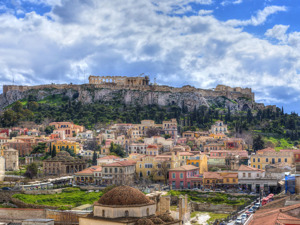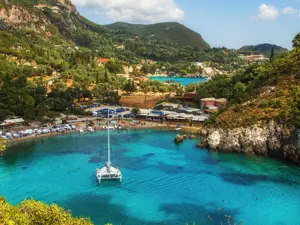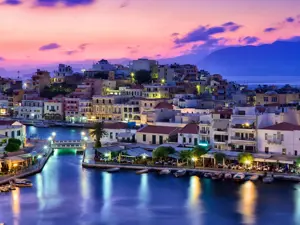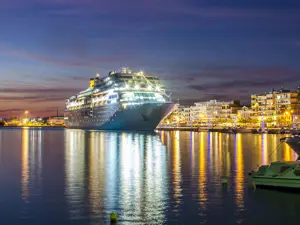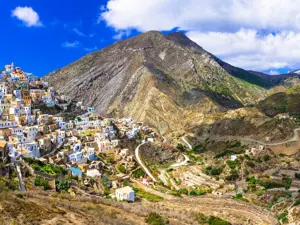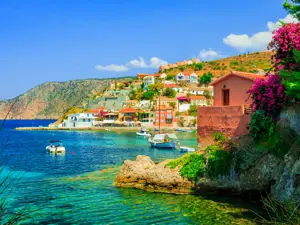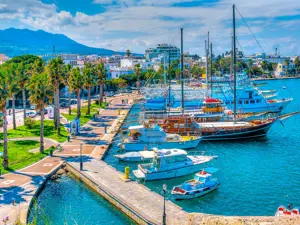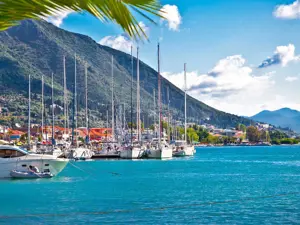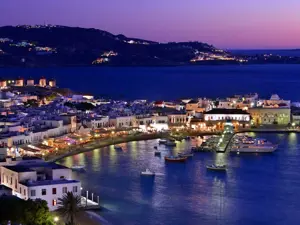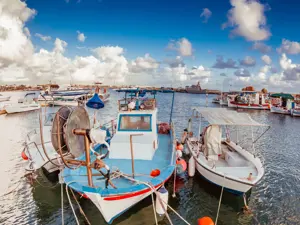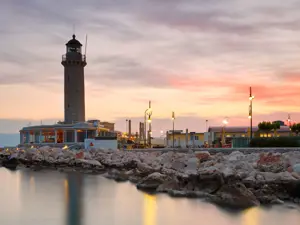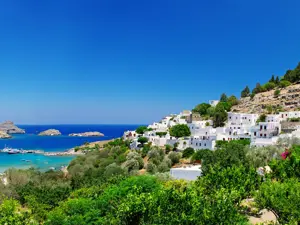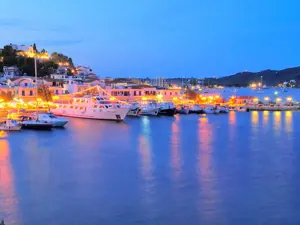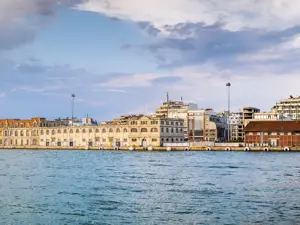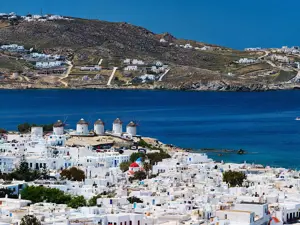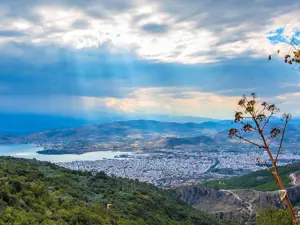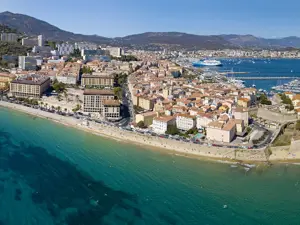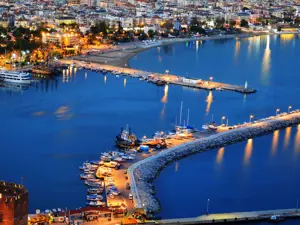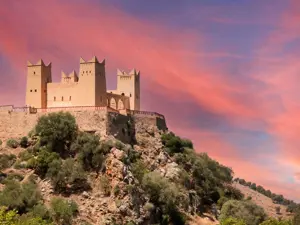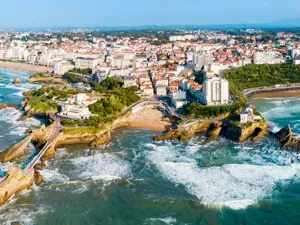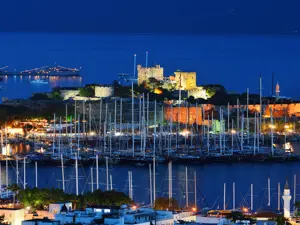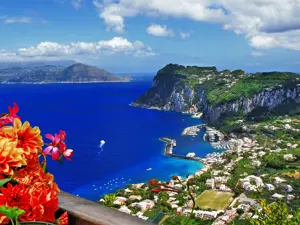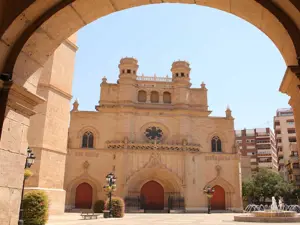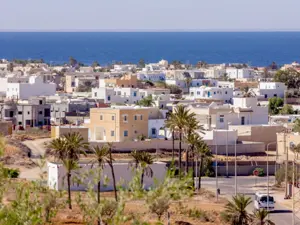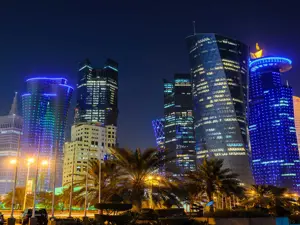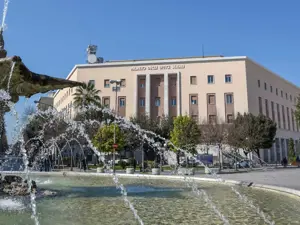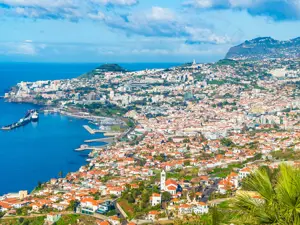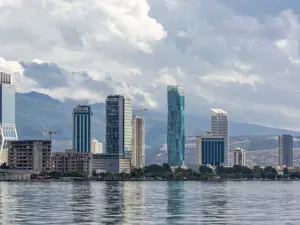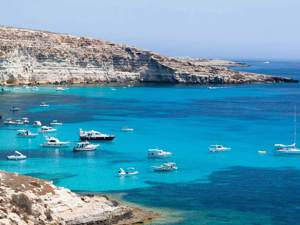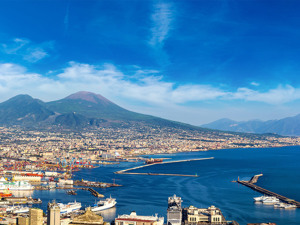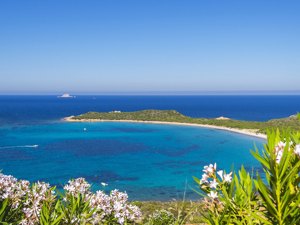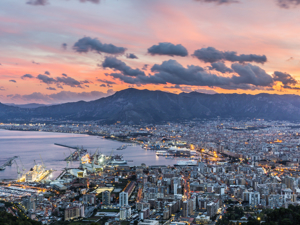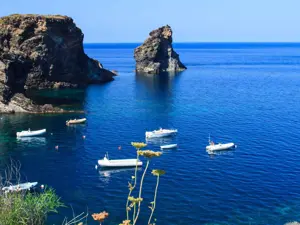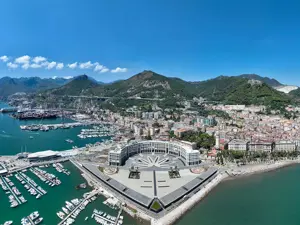The largest of the Cyclades Islands with a romantic charm
The island of Santorini, known also as Thira, has been called a ‘prehistoric Pompeii’, because the artefacts uncovered in excavations had been submersed in lava from horrendous volcanic eruptions that took place thousands of years ago, in exactly in the same way as Pompeii.
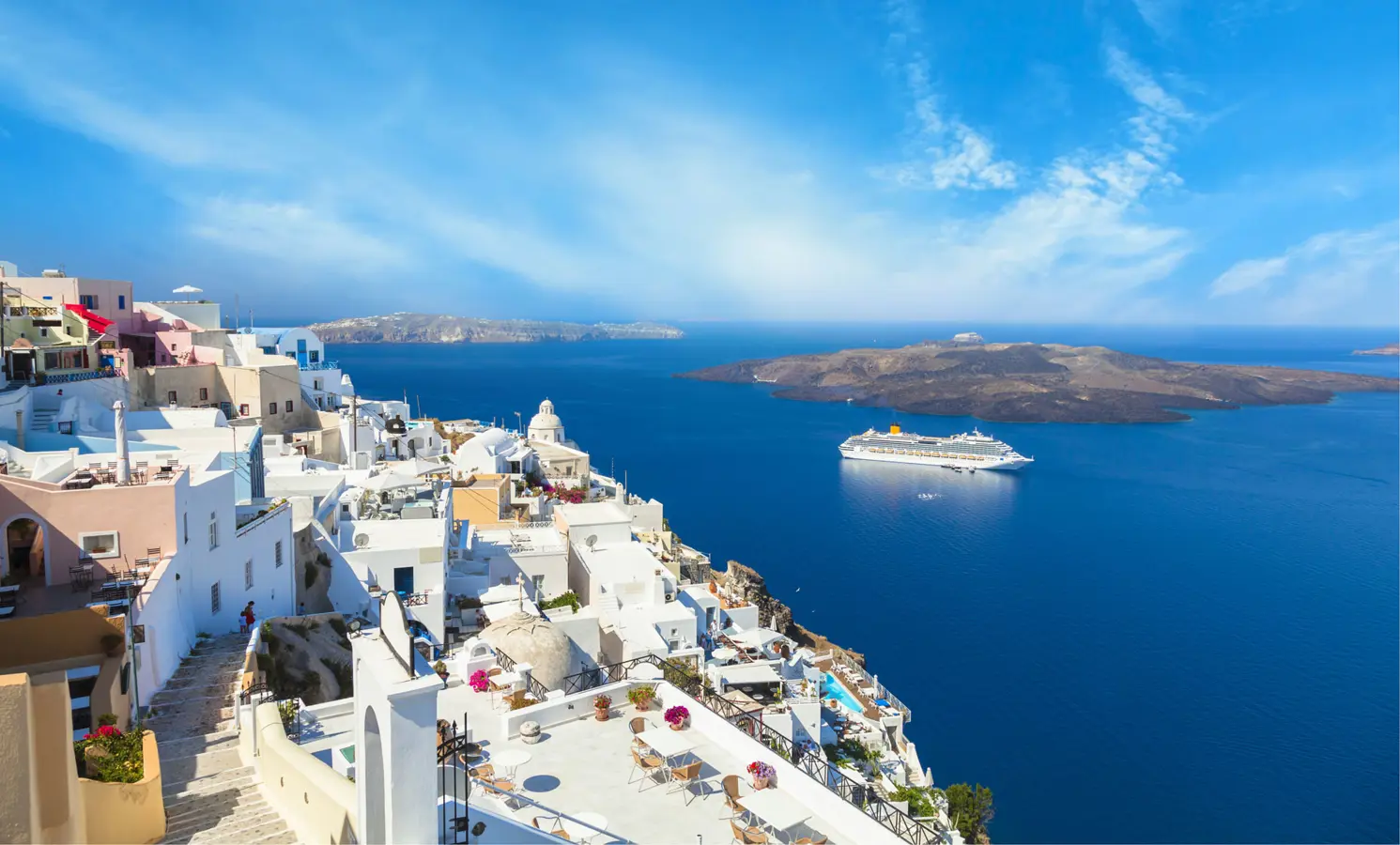
Santorini. Copyright © Sisterscom.com / Shutterstock
Situated in the south east of Greece in the Aegean Sea, Santorini is the largest of the Cyclades Islands, and is itself made up of a small archipelago. The largest island takes the name of Santorini and has a unique appearance given by the powerful contrast between the black lava rocks and the white walls of small single-family houses; Santorini is crowned by the other smaller islands of Thiressia and Aspronisi and by the two islets that form the volcano, Palea and Nea Kameni.
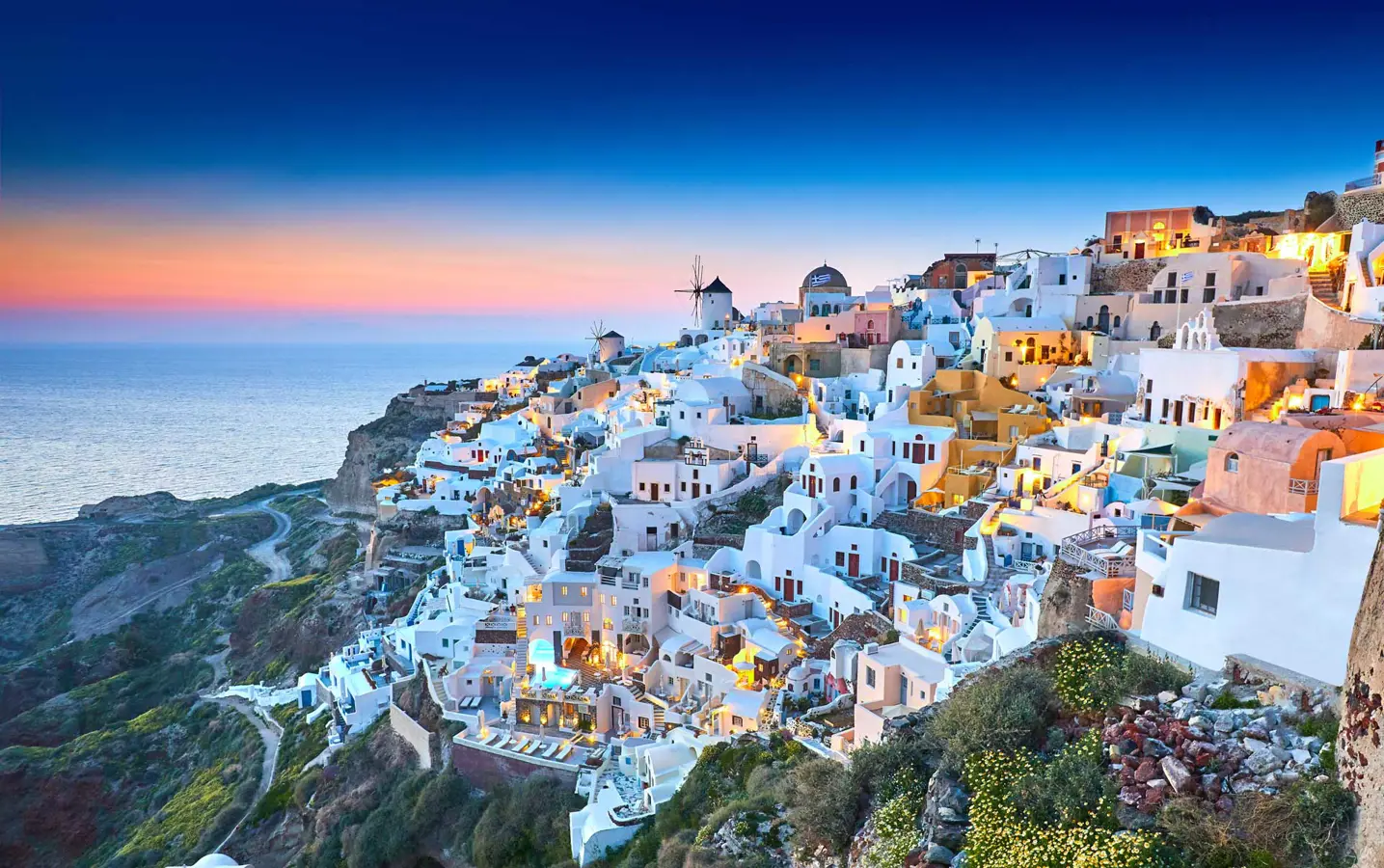
Santorini. Fira. Copyright © Sisterscom.com / Shutterstock
Known in ancient times by the name of Strongyli (which means round, because this was its shape before the eruption), the island has a romantic charm due to its astonishing colours, which make it the preferred destination of tourists, including a large number of couples on honeymoon, who arrive not only from Greece, but also from all over the world.
The Caldera volcano
The island has an active volcano and a crater in the sea, the only example in the world, which bears the name of Caldera. This enormous crater was caused by the sea rushing over collapsed land following a volcanic eruption; the sea here is warm with areas of high temperature due to the presence of sulphurous waters. Overlooking the crater are picturesque villages such as Fira, Firostefani, Imerovigli, Megalochori, Akrotiri and Oia, which offer visitors some incredible sunsets.
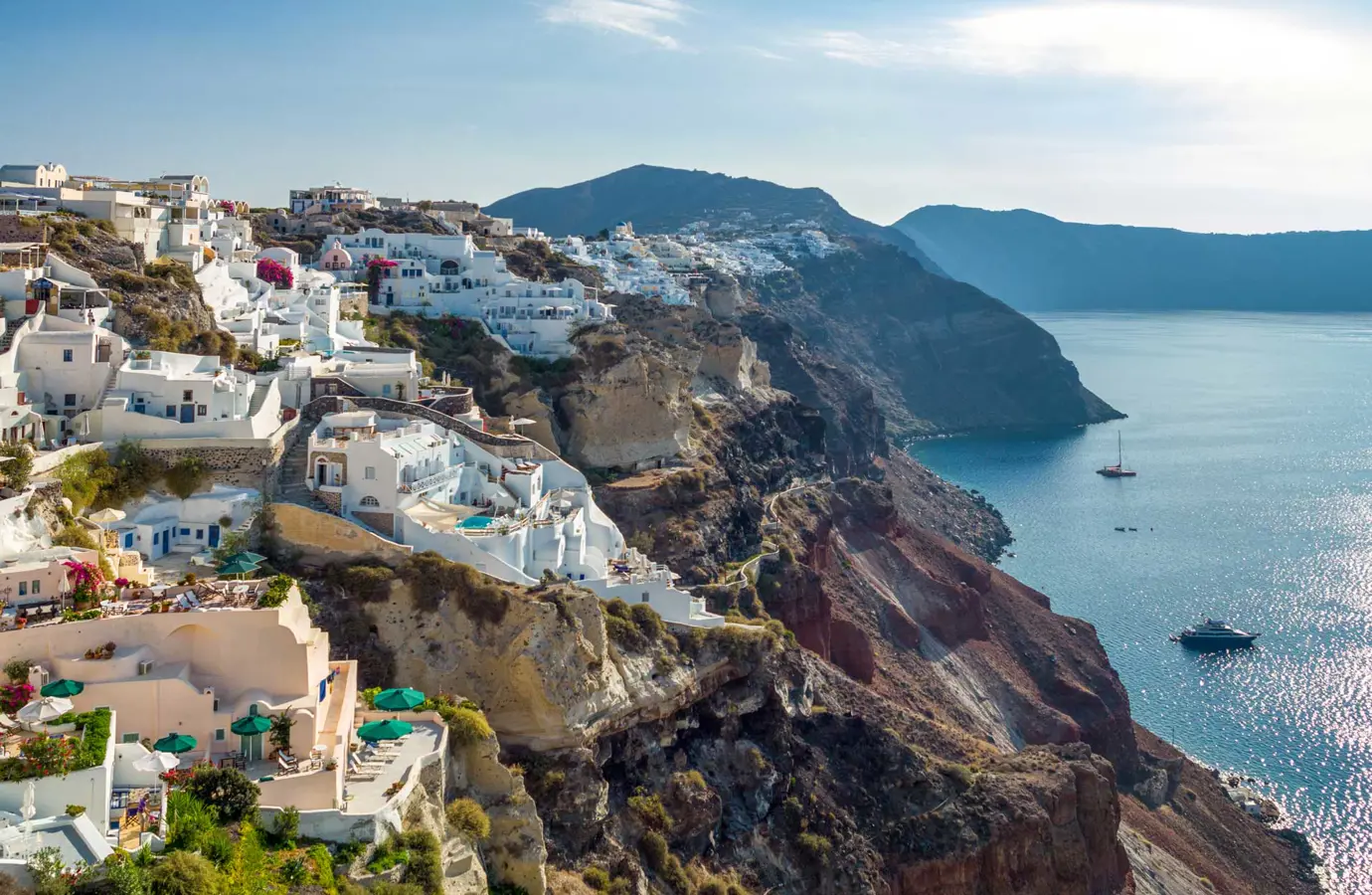
Santorini. Vulcano Caldera. Copyright © Sisterscom.com / Shutterstock
From the Port of Fira, where ships dock, a flight of steps snakes some 585 steps up to the capital of Fira, known also by the name of Thira. For those who prefer not to attempt the arduous climb, patient donkeys and mules wait to take people arriving by boat to the town centre at the top.

Santorini. Fira. Copyright © Sisterscom.com / Shutterstock
This island is not only an attractive destination for lovers of the sea - a deep blue colour with crystal-clear waters - but also for enthusiasts of archaeology, because of the numerous sites where important remnants of civilisations such as the Phoenicians, Dorians, Romans and Byzantines have been uncovered. Over the course of the last few decades interesting finds have come to light that indicate the high level of civilisation of the inhabitants, including stupendous frescoes and fine, richly decorated terracotta items and vases used to preserve beans and other foods. The island’s past has seen 12 enormous eruptions, the first dating back to 20,000 years ago.
The beaches of Santorini
Today the entire island appears like a large natural geology and volcanology museum: beaches with white sand such as White Beach, red such as Red Beach and black such as Kamari beach - the largest and best equipped beach on Santorini - or those covered with volcanic pebbles of varying sizes.
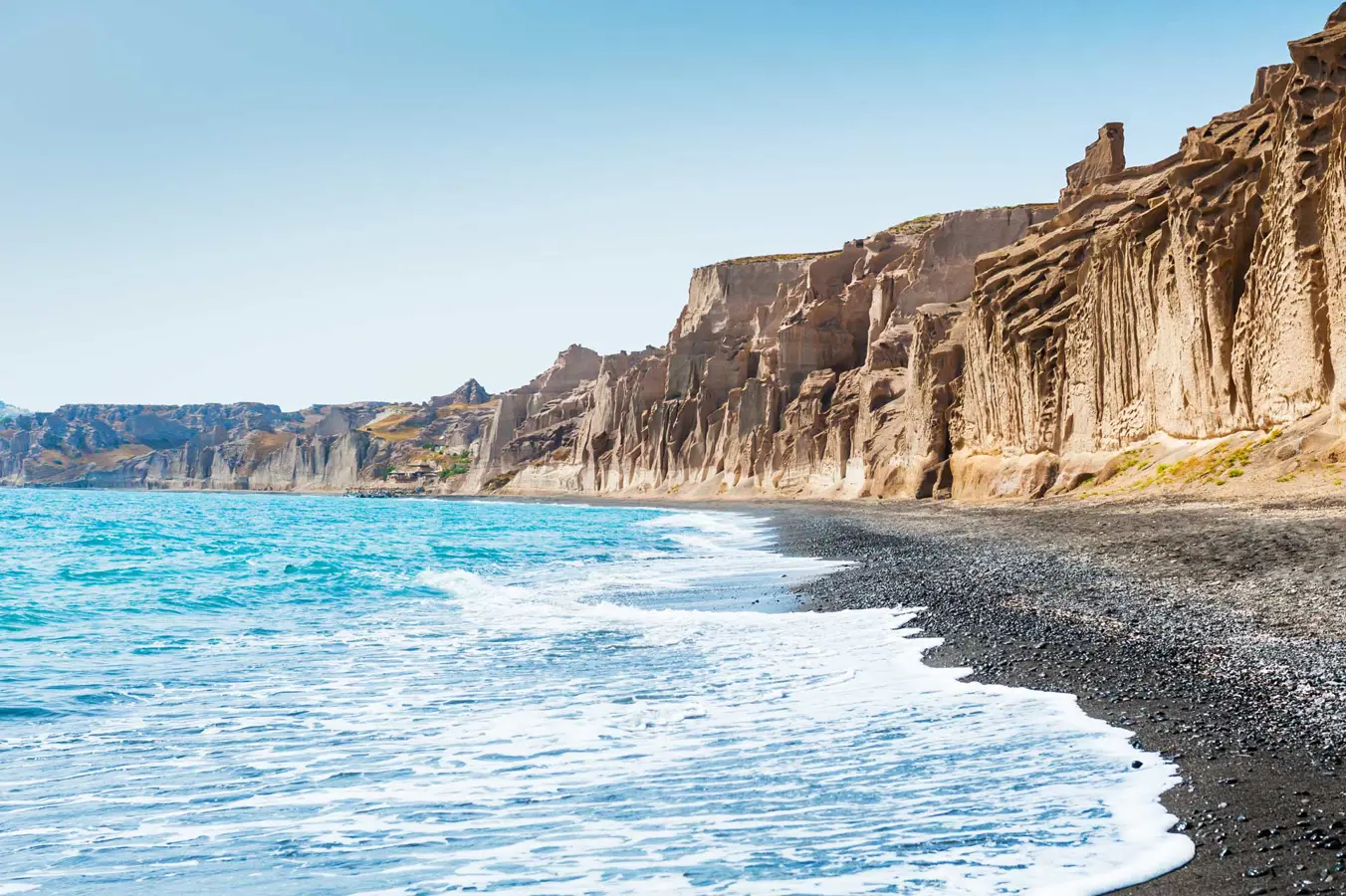
Santorini. Spiaggia Vlychada. Copyright © Sisterscom.com / Shutterstock
The archaeological sites of Santorini
The villages dotted over the island, such as Akrotiri (the Greek word for promontory) or Mesa Vouno, have very important archaeological sites as well as offering visitors an atmosphere of times gone by.
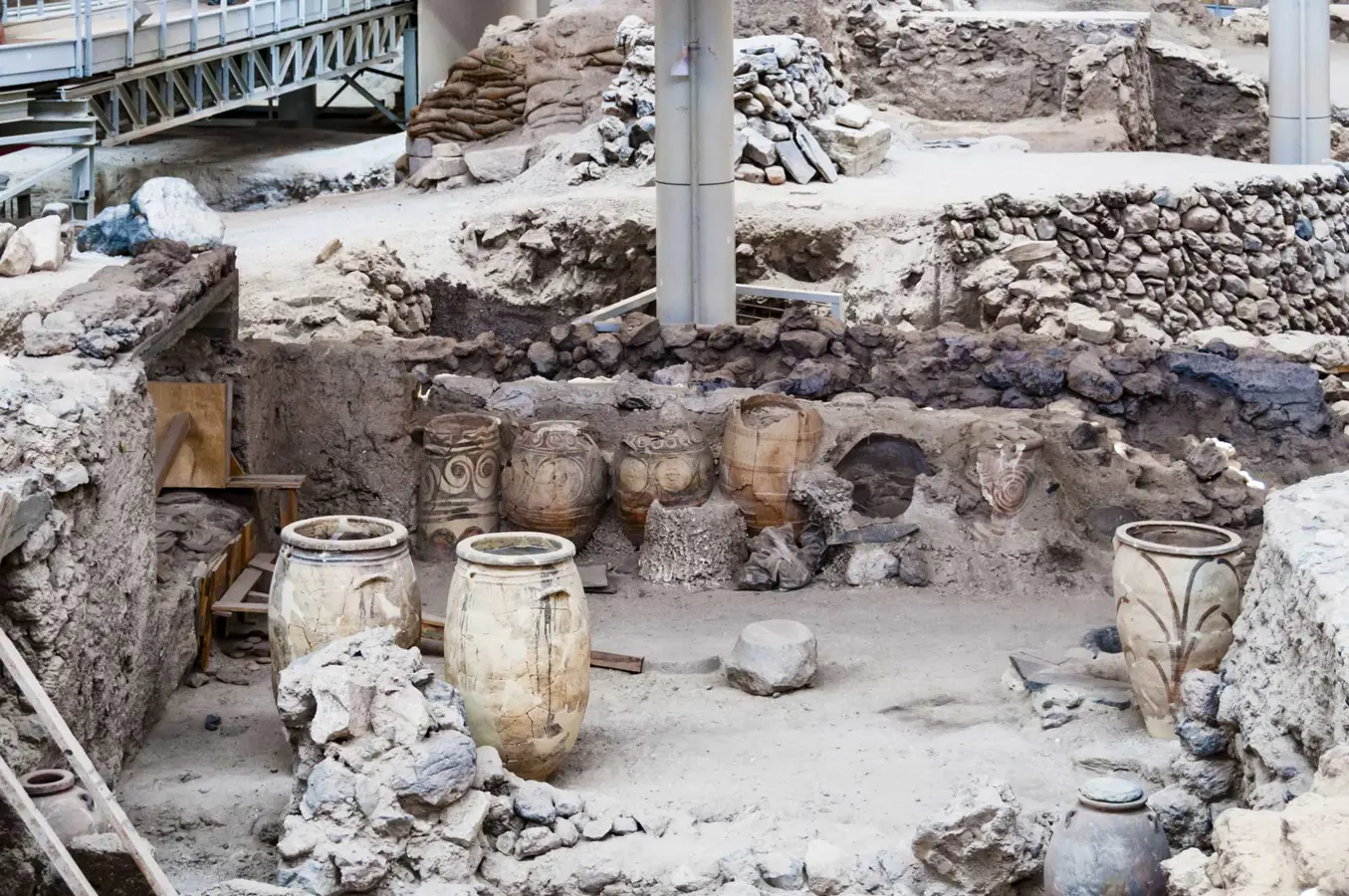
Santorini. Akrotiri. Copyright © Sisterscom.com / Margreet de Groot / Shutterstock
Tourism has not detracted from the island’s atmosphere of hospitable charm, which is seen in the cordiality and friendly and easy-going approach of its inhabitants.
The churches in Santorini
The places of Christian worship are mostly white chapels set in the black rocks, such as the Church of Aghios Nikolaos (St. Nicholas) with its small bell gable, or the Church of St. Stephen of Santorini, which was built on the ruins of a church dedicated to the Archangel Michael with a small dome adorned with rose windows. The religious past also appears in the name of the mountain that dominates the island, which is dedicated to the Prophet Elias, in whose honour a Festival takes place every 20th July.
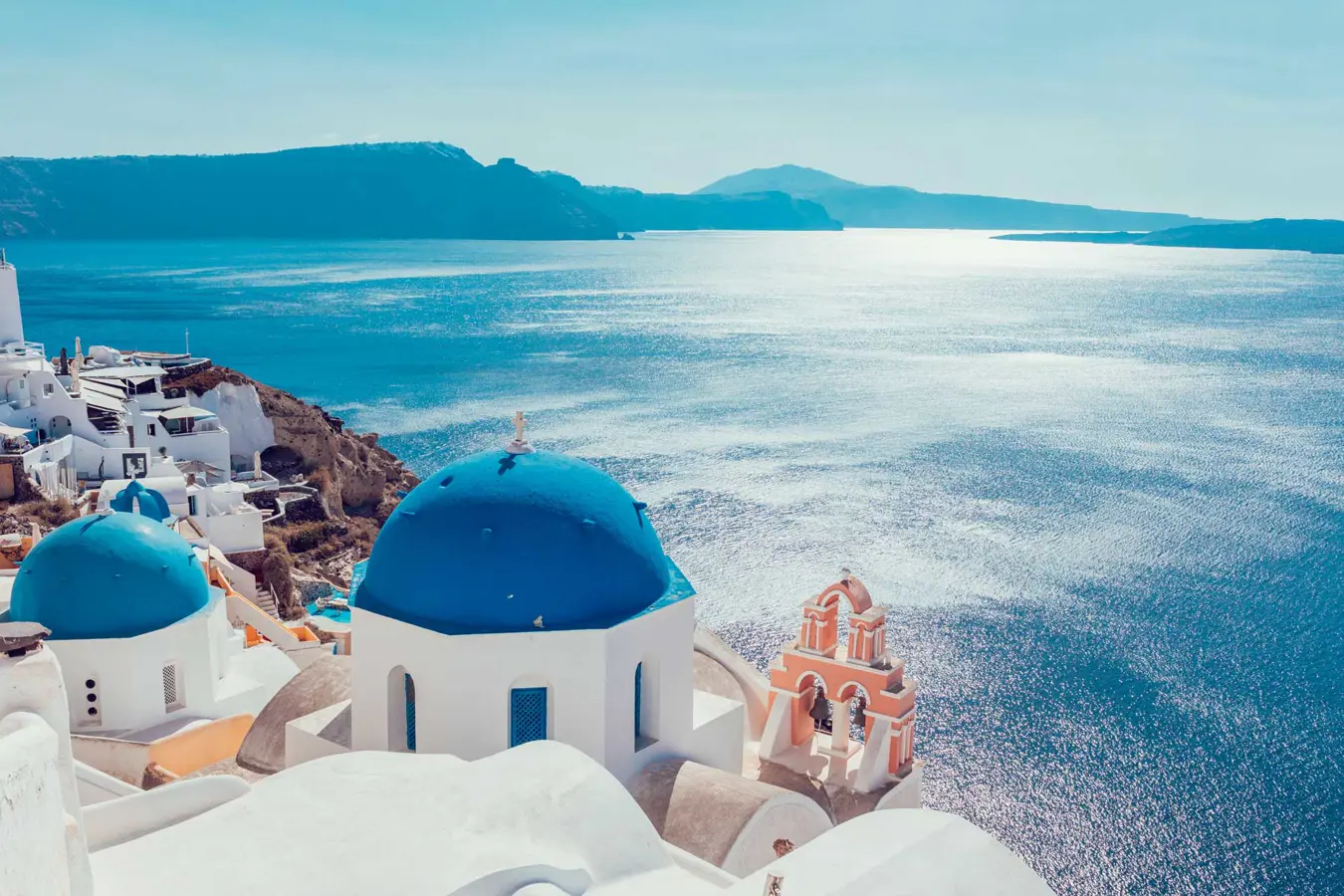
Santorini. Copyright © Sisterscom.com / Shutterstock
Local products and typical dishes
Farming practised on the volcanic land rewards the production of truly excellent wine, including Nykteri, pride of the island, or the famous Vinsanto, or Brusco, a strongly flavoured wine. Also prized are the island’s capers and broad beans, which are eaten mainly at feasts, and cherry tomatoes with which ‘Keftedes me saltsa domata’ (mint-flavoured meatballs) are made.



Some of the island’s best dishes are traditional Greek recipes, such as delicious souvlaki, grilled kebabs made of lamb and pork, moussaka, an exquisite dish of aubergines and minced meat, tomato sauce and potatoes, as well as rice-stuffed vine leaves.
Text by Anna Glik
Updated by Alisè Vitri
Tourism Board
www.visitgreece.gr
www.santorini.gr
Partnership with Booking.com
Where to sleep in Santorini
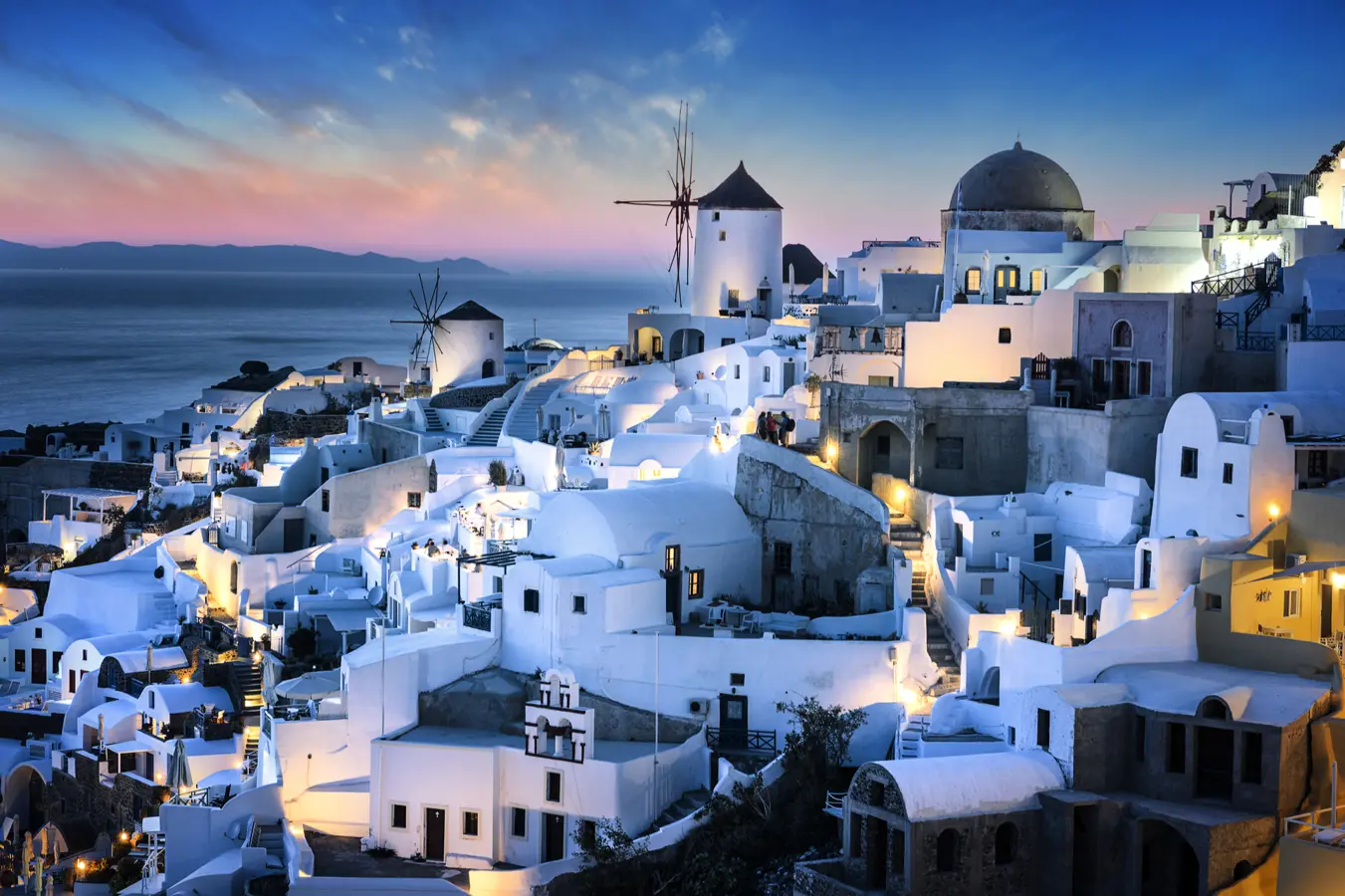
Santorini. Copyright © Sisterscom.com / Shutterstock
Santorini is a welcoming city and offers different possibilities for accommodation.
To find the ideal hotel and the best offers you can do a search for the stars but also for districts or landmarks.
STARS - Santorini Island
Hotels for stars, differentiated by type of services:
LOCALITY
Hotel in the locality of the island, differentiated by type of services:
LANDMARKS
Hotels in tourist areas
AIRPORTS
Hotels near the airports
CYCLADES ISLANDS
Hotel in all Cyclades islands
where to go in santorini
Monuments and Museums in Santorini
ARGYROS MANSION
The most important monument in Santorini, found in the village of Messaria, is Argyros Mansion, the nineteenth-century residence of the landowner and wine merchant George Emanuel Argyros. During the earthquake of 1956, the building suffered serious damage, including partial collapse of the ceiling. Today it has been restored and belongs to the company A.X.T.E. FLORA SA. It brings together local architecture and eclectic elements. The ground floor is a luxury five-star guesthouse, while the upper floor displays the furniture and items of the previous owner as in a refined museum. Worthy of note are the splendid frescoes on the ceiling and the beautiful perfectly preserved nineteenth-century furniture. The house was declared a ‘Work of Art’ by Ministerial Decree in 1995 and railings to protect the building were erected 50 metres from the rest of the site.
THIRA NAVAL MARITIME MUSEUM
Founded in 1956 by the Greek Naval Captain Antonis Dakoronias, the museum has a vast collection of naval instruments of the time when Santorini was a trading port: the ground floor displays sextants, compasses and boat-building tools, and also has a library with navigational maps and documents; the first floor exhibits parts of sailing boats, models, uniforms, portraits of Santorini captains, water colours and photographs of crews and trainees in uniform.
ART SPACE
A unique art centre dug out of the rock in a striking old winery, the Art Space hosts a rich and refined display of contemporary art with hundreds of works of painting and sculpture by Greek and foreign artists, arranged in a tasteful way. Walking through the exhibition halls is a truly unique experience. The old winery continues to exist, but now with very modern organisation, and offers tasting of the some of the best wines of the area as well as fine local products.
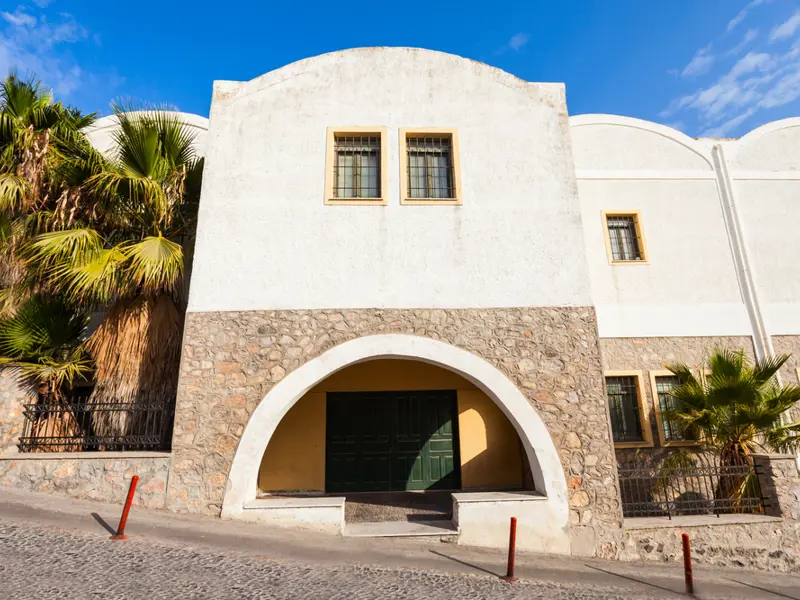
Copyright © Sisterscom.com / Shutterstock
MUSEUM OF PREHISTORIC THIRA
Located in an avant-garde building inaugurated in 2000, the museum houses priceless finds from excavations at Akrotiri dating back to 5,000 years BC. The museum is divided into four themed sections. The first provides details of the excavations carried out in 1967 by Professor Spyridos Morinatos; the second is dedicated to the geology of Thira and the various stages of volcanic activity that formed the island and its small archipelago; the third displays prehistoric items such as fine vessels for domestic use; lastly, the fourth area exhibits pieces from the golden age of Akrotiri, around 1,650 BC.
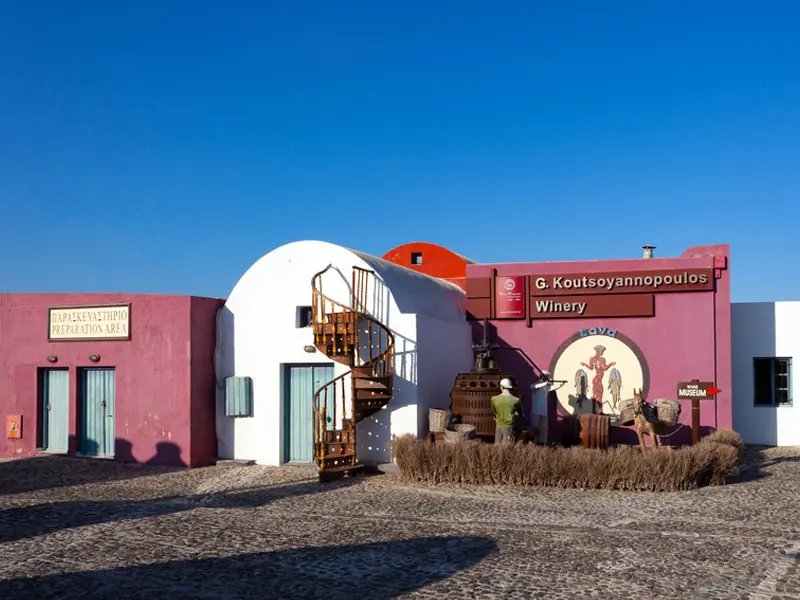
Copyright © Sisterscom.com / Antonio Gravante / Shutterstock
KOUTSOYANNOPOULOS MUSEUM OF WINE
The museum is found in the village of Vothonas, in the cellars of the Volcan Wines estate. Run by the fourth generation of theKoutsoyannopoulos family, it illustrates the history of wine, as well as painted scenes of the daily life of Santorini’s wine producers. Among the more unusual items are an old press of enormous dimensions, nineteenth-century barrels and old machines for manually crushing the grapes. It still has an active winery where, at the end of the tour, visitors can taste the wine estate’s excellent vintages. Visitors can also watch a film telling the story of the island from 150 BC to the present day.
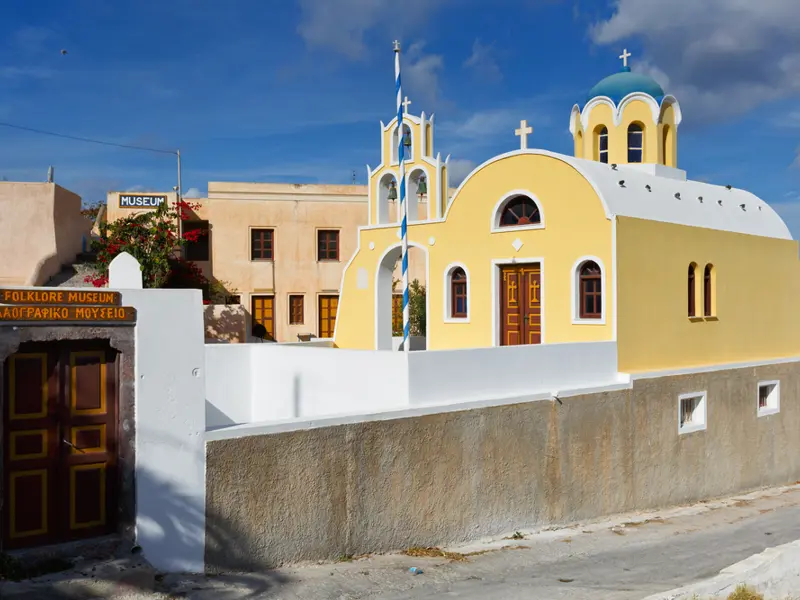
Copyright © Sisterscom.com / Milan Gonda / Shutterstock
THE EMMANUEL LIGNOS FOLKLORE MUSEUM
Situated in the area of Kontochori, just outside the village of Fira, this museum was founded in 1974 by the lawyer and journalistEmmanuel Lignos. Housed in a striking rock-hewn house in 1861, it consists of six rooms that house items connected to the folklore of the island. The salon is perfectly preserved with furniture from the beginning of the twentieth century, photos of the owner and even an old gramophone. The Chapel of St. Konstantine, built in 1993, is found in the courtyard of the museum.
Excursions in Santorini
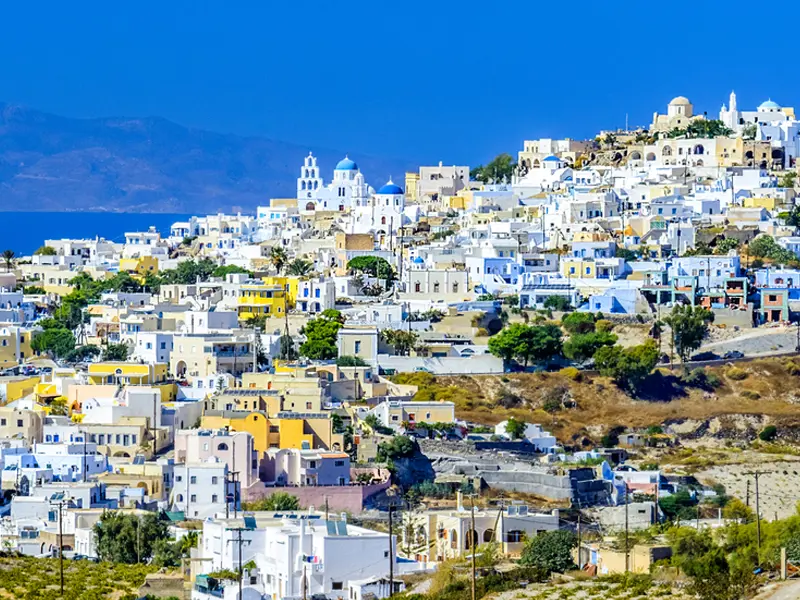
Copyright © Sisterscom.com / Shutterstock
PYRGOS
Pyrgos is a small village located approximately 7 kilometres from Thira with the highest number of churches on the island. The Church of Agia Triada houses a small but rare collection of icons and sacred relics, as well as vestments, holy books, vessels, embroidery for religious use and eighteenth- and nineteenth-century works made of wood and metal. Particularly interesting is the icon of St. George, which probably came from the church dedicated to him, as are the three icons in the Chapel of St. John the Theologian and the two icons painted by the famous iconographer Victor of Crete.
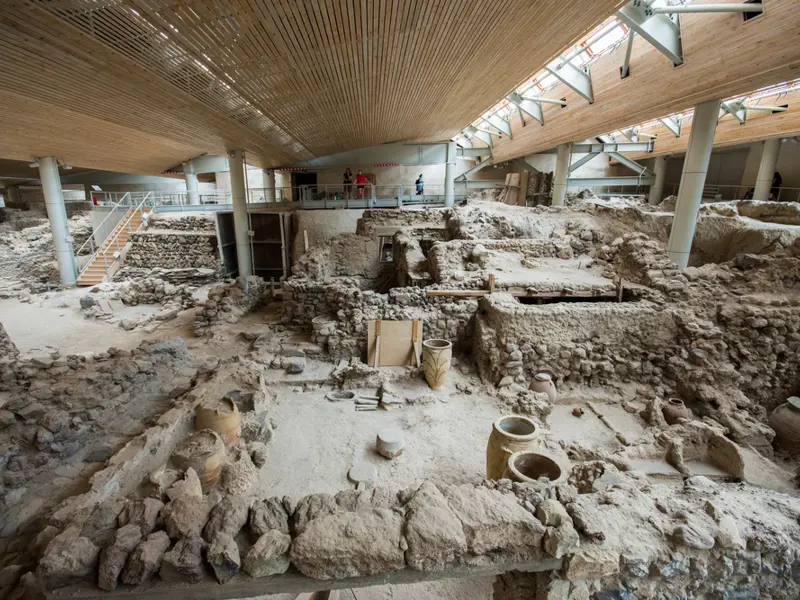
Copyright © Sisterscom.com / Georgios Tsichlis / Shutterstock
EXCAVATIONS OF AKROTIRI
The archaeological site of Akrotiri takes us back to the times and lifestyle of the ancient Atlantis mentioned by Plato. It is reached fromThira by taking the road to Perissa and turning left after 10 km to Akrotiri. The site is one of the most important discoveries of the Aegean and signs of habitation date back to the Neolithic era. Finds seen on the twenty hectare site include amphoras, vases and interestingfrescos such as ‘The Fleet frieze’ and ‘Spring’.
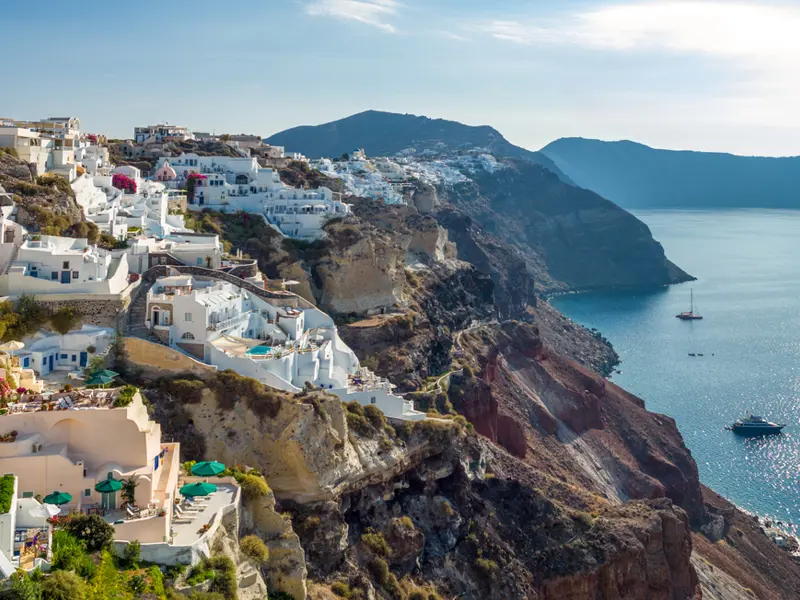
TOUR OF THE CALDERA
An exciting experience is to take a trip around the island by boat, leaving in the morning from the old port of Fira, stopping at Faro, Thirassia, Paleo and Nea Kameni, experiencing the ‘thrill’ of the hot springs and diving into the hot sea of the Caldera, which is rejuvenating and healthy due to the presence of sulphurous waters. The tour ends at the port of Oia, which offers some of the most beautiful sunsets in the world.
Partnership with GetYourGuide
Tours and Excursions
News & Useful info
You might be interested in
Other destinations
Airports nearby Santorini



